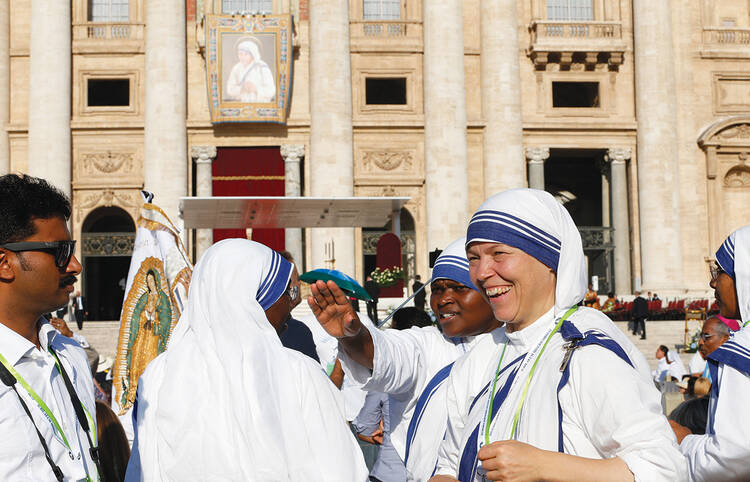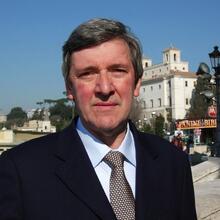Afterward, in an inspiring homily praising her life and work, Pope Francis drew warm applause when he remarked, “I think, perhaps, we may have some difficulty in calling her ‘Saint Teresa’; her holiness is so near to us, so tender and so fruitful that we continue to spontaneously call her ‘Mother Teresa.’”
Pope Francis had invited 1,500 poor and marginalized people—cared for by Mother Teresa’s Missionaries of Charity across Italy—to attend the canonization. He not only gave them privileged places at the ceremony but afterward invited them to a lunch of Neapolitan pizzas in the atrium of the Paul VI audience hall.
In his homily, Pope Francis praised this great woman with whom he has so much in common. “Mother Teresa, in all aspects of her life, was a generous dispenser of divine mercy, making herself available for everyone through her welcome and defense of human life, those unborn and those abandoned and discarded,” he said.
He recalled: “She was committed to defending life, ceaselessly proclaiming that ‘the unborn are the weakest, the smallest, the most vulnerable.’ She bowed down before those who were spent, left to die on the side of the road, seeing in them their God-given dignity; she made her voice heard before the powers of this world so that they might recognize their guilt for the crime of poverty they created.”
He added, “Her mission to the urban and existential peripheries remains for us today an eloquent witness to God’s closeness to the poorest of the poor.”
Last December, Francis decided to hold the canonization of Mother Teresa on the Jubilee for Workers of Mercy and Volunteers, a day when those volunteers and workers from all over the world came to Rome for their part in the Jubilee Year of Mercy. The pope sees Mother Teresa as an icon of mercy for the modern world.
“Today,” he said, “I pass on this emblematic figure of womanhood and of consecrated life to the whole world of volunteers; may she be your model of holiness!”
When he finished speaking, the crowd broke into thunderous applause. Then, after prayers in different languages, Francis went on to concelebrate Mass with the more than 70 cardinals, 400 archbishops and bishops and 1,700 priests present at the ceremony.
The crowd included numerous women and men religious, including many members of the Missionaries of Charity. Following the liturgical tradition, a few of them placed a blood relic of Mother Teresa near the altar immediately after the canonization.
Also attending the ceremony was the Brazilian man who was cured through Mother Teresa’s second miracle, Marcilio Haddad Andrino, together with his wife. No fewer than 15 countries, including the United States, sent official delegations to the ceremony to honor “the saint of the slums.”
The presence of these delegations, which included representatives of different faiths, was hardly surprising, given that even during her lifetime, Christians and followers of other religions—Hindus, Sikhs, Jews, Muslims and Buddhists and many people who do not profess a religion—considered this extraordinary woman a saint. When she died on Sept. 5, 1997, India recognized her greatness by giving her a state funeral.
Now, 19 years after her death, the Catholic Church has officially recognized her as a saint. She is the first Nobel Peace Prize winner to be so honored.








